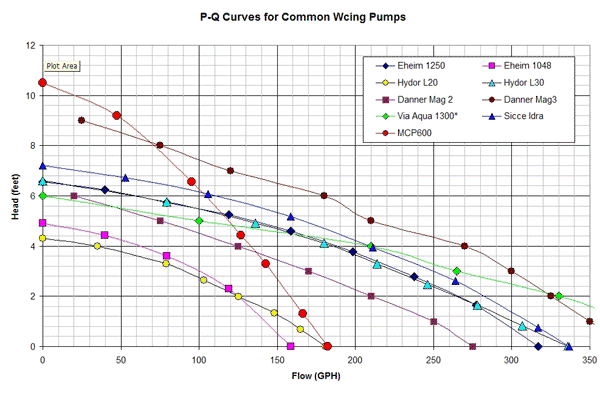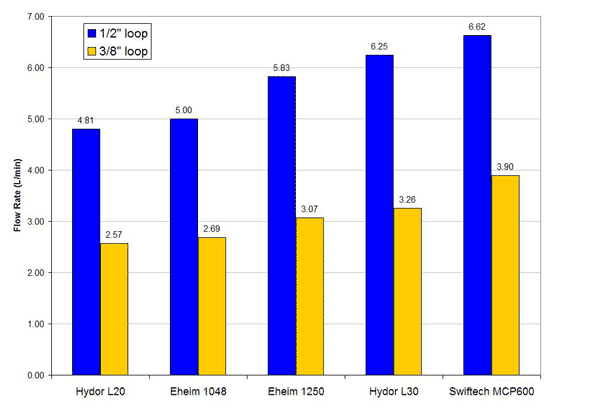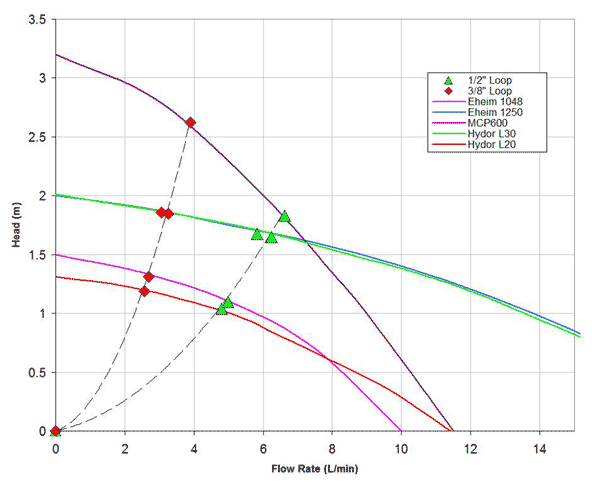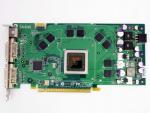|
|
|
|
 Pump Comparison Pump Comparison
|
|
Date Posted: Nov 16 2003
|
|
Author: pHaestus
|
|
|
|
|
Posting Type: Article
|
|
Category: H2O and Evap
|
|
Page: 1 of 1
|
|
Article Rank:No Rank Yet
Must Log In to Rank This Article
|
|
|
|
|
Note: This is a legacy article, imported from old code. Due to this some items on the page may not function as expected. Links, Colors, and some images may not be set correctly.
|
|
|
Pump Comparison By: pHaestus
|
|
|
|
|
ProCooling Pump Comparison
By: pHaestus 11/16/03
|
|
|
|
|
SUMMARY: Real world pump performance in a water cooling loop is significantly less than maximum flow rates reported on boxes and labels. By interpreting a manufacturer's P-Q curve, you can make a far better choice of pump for your specific cooling system. Of the pumps tested, the Swiftech MCP600 is clearly the best choice for very restrictive cooling loops. For those looking for silence while water cooling, the Eheim 1048 and Hydor L20 are both good choices.
|
|
Without a doubt, one of the most popular questions in the Pro/Forums is "What pump should I choose for this system?" This is a reasonable question because pumps vary pretty widely in performance, noise, and reliability, many people are somewhat confused about how to interpret technical data provided by pump manufacturers, and there are a lot of contradictory opinions available on the web. The purpose of this article is to assist our readers in choosing a pump for their water cooling loop by providing some real world test results for centrifugal pumps and by demonstrating how they relate to flow resistance and pump P-Q curves.
A good place to begin this article is a short introduction on how centrifugal pumps work. The following quoted text is summarized from here and not my own words.
"Centrifugal pumps have an impeller that is attached to a shaft and is driven by the motor. Water enters the pump at the eye of the impeller and exits the impeller via centrifugal force. A low pressure area is created as water exits the impeller which causes more water to flow into the eye. Velocity is developed as the water flows through the impeller while it spins at high speed. The water velocity is converted to pressure by specially designed passageways that direct the flow to the pump outlet. The head (or pressure) that a pump will develop is in direct relationship to the impeller diameter, the number of impellers, the size of impeller eye, and shaft speed. Capacity is determined by the exit width of the impeller. The more water to be pumped, the more energy is required. The greater the depth to the water, the less the pump will pump. Also, when it pumps against increasing pressure, the amount of water pumped will decrease."
The sentence in bold is key to understanding the need for a curve to describe the relationship between pressure and work (P vs. Q) for pumps. The energy put into a pump does is used to move water and to overcome resistance. As resistance to flow increases, the flow rate must decrease given a constant power input. So the flow rate that a pump will produce in any setting is determined by the total resistance of the loop into which it's plumbed. Let's take for example several pumps that all have a 300GPH flow rate at 0 head but very different maximum pressure ratings. When you plumb these different pumps into the same water cooling loop, you will get different final flow rates because they respond to restriction differently. Given this background, hopefully P-Q curves make a little more sense. Here are manufacturer's curves for many of the most common water cooling pumps:
|
|
|
 |
|
|
|
A couple of comments are in order. (1) These curves were compiled by searching manufacturer web sites links found here. If you don't see technical data listed in our links for a pump manufacturer then please add it via the web interface. (2) In my opinion the Via Aqua numbers are a bit suspect. I base this on the fact that their web site had tabulated numbers and a graph but they didn't match up very well. (3) Manufacturers may stretch the truth to differing amounts. I am sure you've all bought "silent" cooling fans before that didn't live up to expectations.
Some terms used by manufacturers to describe the performance of pumps are worth defining as well. Maximum pressure at deadhead (or max. head) is the pressure that a pump can produce when it is pumping against complete obstruction (such as a fully closed valve). On a P-Q curve, this point would be the pressure where flow equals zero. Free flow at no resistance (or max. flow) is another useful term that describes the flow rate that a pump can produce when no resistance is present. On a P-Q curve, this point would be the flow where pressure equals zero.
A P-Q curve is useful, but it is only half of the story when choosing a pump. The other consideration is the resistance of your water cooling loop. To make things somewhat more complicated, the resistance of your system also changes with flow rate. This makes sense when you think about it: as you try to force more and more water through a bottleneck then there is increasing resistance to flow. In rough terms pressure is related to flow rate squared (P = xQ2), and in principle one can determine the total flow resistance of their cooling loop by finding pressure drop vs. flow rate data for each component (blocks, radiators, fittings, hose, res, etc), deriving a P-Q equation for each component, and then adding them all up. In practice we as a community need much more test data (bug your friendly neighborhood manufacturer).
It is also useful to test real world flow rates of different pumps in typical water cooling loops. This can help determine whether the published P-Q curves are realistic and can give a simple ballpark flow rate that you should expect. Testing several water cooling pumps to show how they perform in real cooling loops is the purpose of this article. The pumps chosen were the Eheim 1048 and 1250, the Hydor L20 and L30, and the Swiftech MCP600.
|
|
I have quite a few pumps lying around the house from one project or another so I was able to round up a reasonably good cross section to test. The Hydor L20, L30, and Eheim 1048 were all provided by Cooltechnica, the Eheim 1250 is on loan from KnightElite (a Pro/Forums regular), and the Swiftech MCP600 was provided by Swiftech. I initially tested a couple of additional pumps, but I didn't have manufacturer's P-Q curves and so they aren't included in this article. The below numbers are from the manufacturers and apply to the US version of the pumps (115V 60Hz).
Hydor L20
The L20 has a free flow rate of 185 GPH (700 LPH), a dead head pressure of 50" (1.35 m), a power consumption of 11W and comes stock with 1/2"OD (13mm) barbed fittings on both inlet and outlet. The L20 is the smallest pump that I tested, with dimensions without accessories (fittings, suction cup base) of 3.5"(89mm) x 2"(51mm) x 3" (76mm). The L20 is also the least expensive pump in this comparison, at $35US. In my use of the L20, I found it to be an extremely quiet pump that is easy to fit into small places. One should take care that the impeller housing is securely locked into place by the blue cover or else the pump will leak. This is just user error and not a big problem but something to note.
Hydor L30
The L30 is the big brother of the L20, and has a free flow rate of 320 GPH (1200 LPH), a dead head pressure of 75" (1.95 m), a power consumption of 23W and also comes stock with ½" OD fittings. The L30 has similar specs to the Eheim 1250 but is MUCH smaller, at 4.5"(114mm) x 3"(76mm) x 3.5"(89mm) without fittings or suction cups. The L30 retails for $50. I have had the L30 in my water cooling loop for about 6 months and have not had any problems with it. The L30 does make a humming noise that is louder than the L20 or Eheim 1048 but not too obtrusive. My WD HDD noise was more annoying.
Eheim 1048
The 1048 has a free flow rate of 158GPH (600LPH), a dead head pressure of 59" (1.50 m), power consumption of 10W and comes stock with ½" OD fittings. Eheim pumps tend to be larger than other mag-drive brands of similar spec, and the 1048 is no exception. It measures at 5.8" (147mm) x 3" (75mm) x 4.7"(118 mm), or almost twice the size of the L20. The Eheim 1048 retails for $57. Eheim pumps have a great reputation among water coolers because of quiet operation and reliability. The 1048 has been a particular favorite of mine due to its low noise.
Eheim 1250
The 1250 has a free flow rate of 317GPH (1200 LPH), a dead head pressure of 79" (2 m), a power consumption of 28W, and comes with a 5/8" OD inlet and ½" OD outlet barbs. The 1250 is a pretty large pump, at 7.1" (180mm) x 3.8" (95mm) x 14.7" (20mm). The 1250 retails for $68. The Eheim 1250 that I tested had seen some abuse at the hands of KnightElite (a crack at the outlet) and I repaired it by JB Welding a 3/8" copper pipe fitting with ½" NPT female threads onto the outlet side. For testing I used a ½" OD hosebarb to try and reproduce stock performance as closely as possible. If anything this modification should slightly improve the 1250 performance because the outlet has less restriction than with the stock barb inserted.
Swiftech MCP600
The Swiftech MCP600 is the most unique pump in the comparison for several reasons. First of all, it is a 12VDC pump rather than AC. There are no concerns about reliability with this DC pump, as it has a brushless motor and is designed for continuous operation. The other interesting design feature of this pump is its closed impeller design. This design allows the MCP600 to produce more pressure than open impeller-type pumps (every other pump tested). It has a free flow rate of 160GPH (600LPH), a dead head pressure of 86" (2.2 m), and a power consumption of only 9W. The MCP600 has ½" inlet and outlet barbs molded onto the impeller housing. The MCP600 retails for $78.99. When testing the MCP600, I noticed that on initial power up it was quite noisy. After a day or so of settling in, the noise diminished a lot and flow rate slightly increased. Bill Adams at Swiftech attributed this to bearing wear in, which seems reasonable. The MCP600 is still the loudest pump of the crowd but its noise can be dealt with fairly well with isolation using foam.
If I hadn't explained the P-Q curves and system resistance earlier, then you might be inclined to rank the pumps based upon their maximum flow rate: Eheim 1048 < Swiftech MCP < Hydor L20 < Eheim 1250 < Hydor L30. This is of course not how things play out in the real world, and we'll now report a few tests to show exactly how wrong that this ranking turns out to be.
|
|
To measure flow rates, a GPI digital flowmeter was used (1% accuracy; 0.3-3GPM range). Each test was done in triplicate by completely draining the loop and refilling, and there was never a difference larger than 0.01GPM in the results. Note that the flowmeter will cause additional resistance in the loop and so reported flow rates somewhat underestimate the "real" flow rates users could expect.
Two test loops were assembled to be representative of a low restriction and a high restriction cooling loop. For the low restriction loop, ½" hose barbs and ½" ID Tygon thickwall tubing was used. A Dangerden Maze4, a Black Ice Extreme radiator, the GPI flowmeter, and a 1 gallon reservoir were all plumbed in a loop and the system was tested with the reservoir open to the atmosphere.
For the high restriction loop, 3/8" ID vinyl tubing was used along with a Swiftech MC5000-A CPU waterblock, a MC-50 GPU waterblock, two Black Ice Micro radiators, and the Swiftech 3 valve fill and bleed kit. The loop was initially filled by connecting the 3 valve fill and bleed kit to the 1 gallon reservoir used in the ½" system to rapidly purge the air from the loop. Once the loop was free of air, the valves were switched to force water to run inline through the fill and bleed kit rather than through the res.
|
|
It is convenient to graph all of the pump performance numbers together for comparison.
|
|
|
 |
|
|
|
When this is done, a clear trend emerges for flow rates in both 3/8" and ½" tests: Hydor L20 < Eheim 1048 < Eheim 1250 < Hydor L30 < Swiftech MCP600. This is a much different ranking than one would arrive at by looking at the maximum flow rates of these pumps. Another item of note is that the 3/8" loop really stresses the pumps. Only one pump (the MCP600) manages a flow rate of 3.8L/min (1 GPM). This is the minimum flow rate I shoot for in a cooling loop because most of the blocks I have tested out seem to have noticeably poorer performance at flow rates less than this. Therefore for 3/8" systems with multiple blocks, the MCP600 is the obvious pump to choose. For the ½" loop it appears that all of the pumps can produce acceptable flow rates, and so choice should be made based upon size (L20, MCP600, L30), noise levels (L20, Eheim 1048), cost (L20, L30), or a combination. For people who are beginning with a CPU block now but are considering adding a GPU or northbridge block later, the L30 and the MCP600 offer the most headroom for block additions.
Les from the Pro/Forums graphed the results of my pump testing in an extremely interesting and useful way. I thought that the graph was quite illustrative of the relationship between pump P-Q curves and cooling loop resistance and so I have reproduced the graph here (thanks again Les!).
|
|
 |
|
|
|
So what is this graph exactly? The colored lines are the P-Q curves of the pumps, and the data points (diamonds and triangles) are the results of the ½" and 3/8" testing. The pressure for these points was estimated by referring to the pump P-Q curves (assuming the manufacturer's numbers are reasonable, then one can determine pressure by knowing flow rate). It is possible to fit a second order polynomial (y = ax2) to the experimental data (the dashed line). This dashed line is equal to the total cooling system resistance. You can see that the 3/8" cooling loop has a much higher resistance (pressure) for a given flow rate. The result of this is that pumps aren't able to sustain a very high flow rate in this loop. The resistance of the ½" loop is lower, and so actual flow rates are significantly higher. The Eheim 1250 is the only pump whose performance doesn't fall on the fitted total resistance curve. There are two possible explanations for this: Eheim's specifications may be a bit optimistic for the 1250 or the modifications done to the 1250 to stop leaking may have somewhat hampered its performance.
If your waterblock and radiator have pressure drop vs. flow rate available for them (check Bill Adams' testing at www.thermal-management-testing.com and www.overclockers.com for test data), then you should be able to estimate your total system resistance. Just add the resistance of the wb, the rad, the tubing, and the fittings you are using and you should get pretty close.
|
|
Real world pump performance in a water cooling loop is significantly less than maximum flow rates reported on boxes and labels. By interpreting a manufacturer's P-Q curve, you can make a far better choice of pump for your specific cooling system. With our testing, we could obtain a crude estimate of total system resistance by measuring the flow rates of different pumps and correlating them with manufacturer P-Q curves. The results hopefull give you an idea of what sort of flow rates to expect in YOUR loop with these pumps. Of the pumps tested, the Swiftech MCP600 is clearly the best choice for very restrictive cooling loops. The aquarium pumps tested just couldn't deal with the restriction of a 3/8" loop with multiple waterblocks and radiators. This brings us to another point, actually. If you are planning on using a Hydor or Eheim pump, then it is quite worthwhile to put some attention into lowering the resistance of your loop (no 90 degree elbows, use ½" tubing, perhaps move up to 5/8" hosebarbs). For those looking for silence while water cooling, the Eheim 1048 and Hydor L20 (in a low resistance ½" loop) are both good choices. The L30, 1250, and MCP600 are noticeably louder.
|
|
I do want to make note of an issue that has cropped up recently where some MCP600 pumps are dying after a few weeks of use. I have seen a quote directly from Bill Adams at Swiftech on this issue:
"The problem affecting 2-3% of the pumps has been identified as a failure of the thrust bearing (a Ryton washer) between the impeller and the front shaft support hub (the pump motors are fine)
- the hub is being redesigned to utilize a ceramic bearing face
In the meantime, failed pumps are being replaced with a new pump head assembly having a slightly reduced diameter impeller
- this reduces the deadhead pressure capability ~0.5m, the actual effect on the CPU temp will not be noticeable in most systems.
when the revised pump heads are available they will be provided to all who wish them w/o charge of course."
So at this moment performance of the MCP600 may be slightly less than the pump that is tested today. If so, though, you will be able to get a new pump head from Swiftech at no charge that will return your pump to its rated performance. I still am recommending this pump (and in fact I am running the MCP600 in my main PC), but I also recommend that you ask retailers whether the pump is the original version, the temporary fix version, or the redesigned ceramic bearing face version.
|
|
Thanks to Bill Adams and Swiftech for supplying the MCP600, MC5000A, MC-50, fill and bleed kit, and Black Ice Micro radiators. Thanks to Bruce at Cooltechnica for providing the Hydor L20, L30, and the Eheim 1048 pumps. Thanks to KnightElite for loaning me the Eheim 1250. And finally thanks to Les for his thoughtful comments and interpretation of the test data.
|
|
|
|
| Random Forum Pic |
 |
| From Thread: Graphics card PCB layout diagrams |
|
| | ProCooling Poll: |
| So why the hell not? |
|
I agree!
|
 67% 67%
|
|
What?
|
 17% 17%
|
|
Hell NO!
|
 0% 0%
|
|
Worst Poll Ever.
|
 17% 17%
|
Total Votes:18Please Login to Vote!
|
|






 Pump Comparison
Pump Comparison


